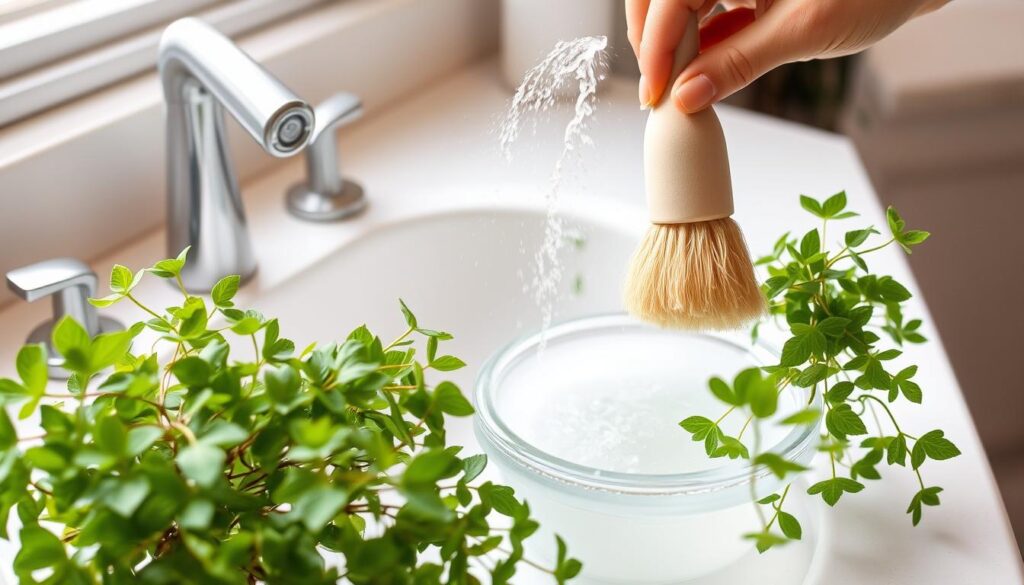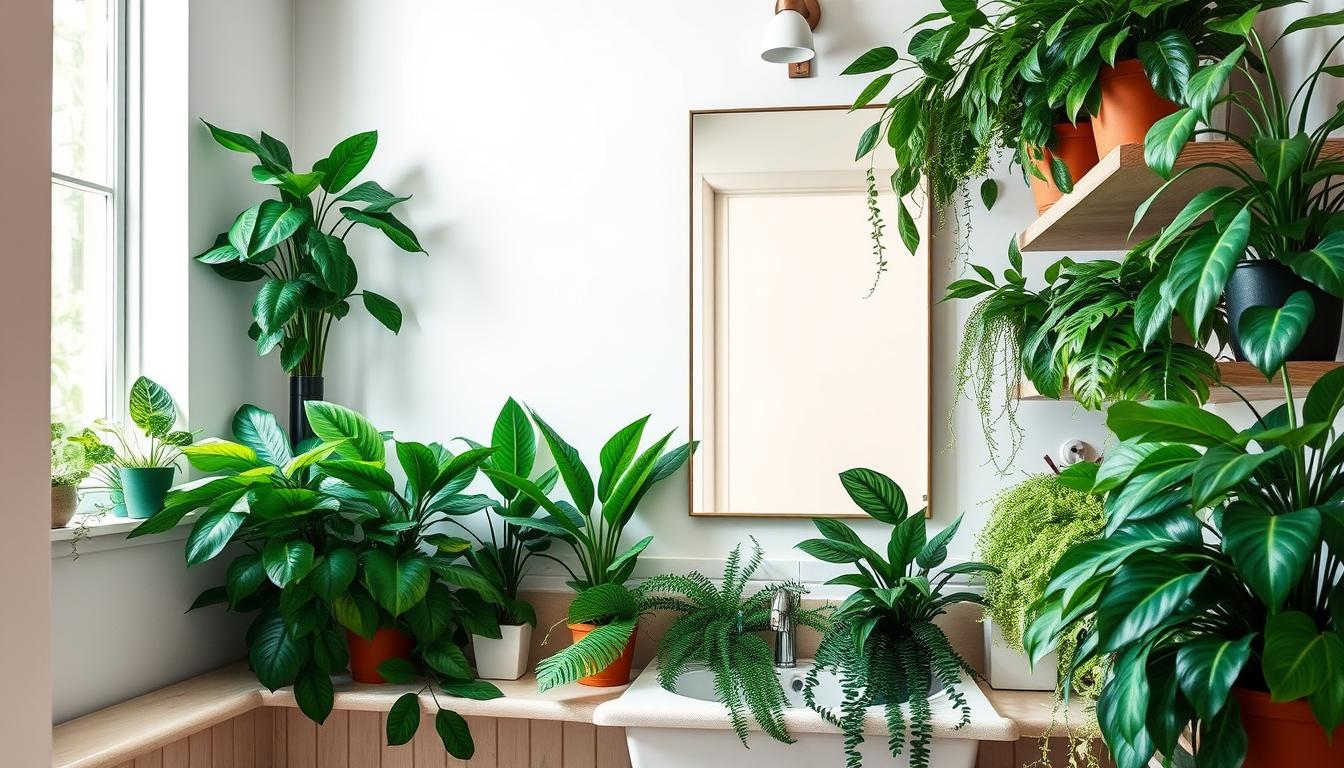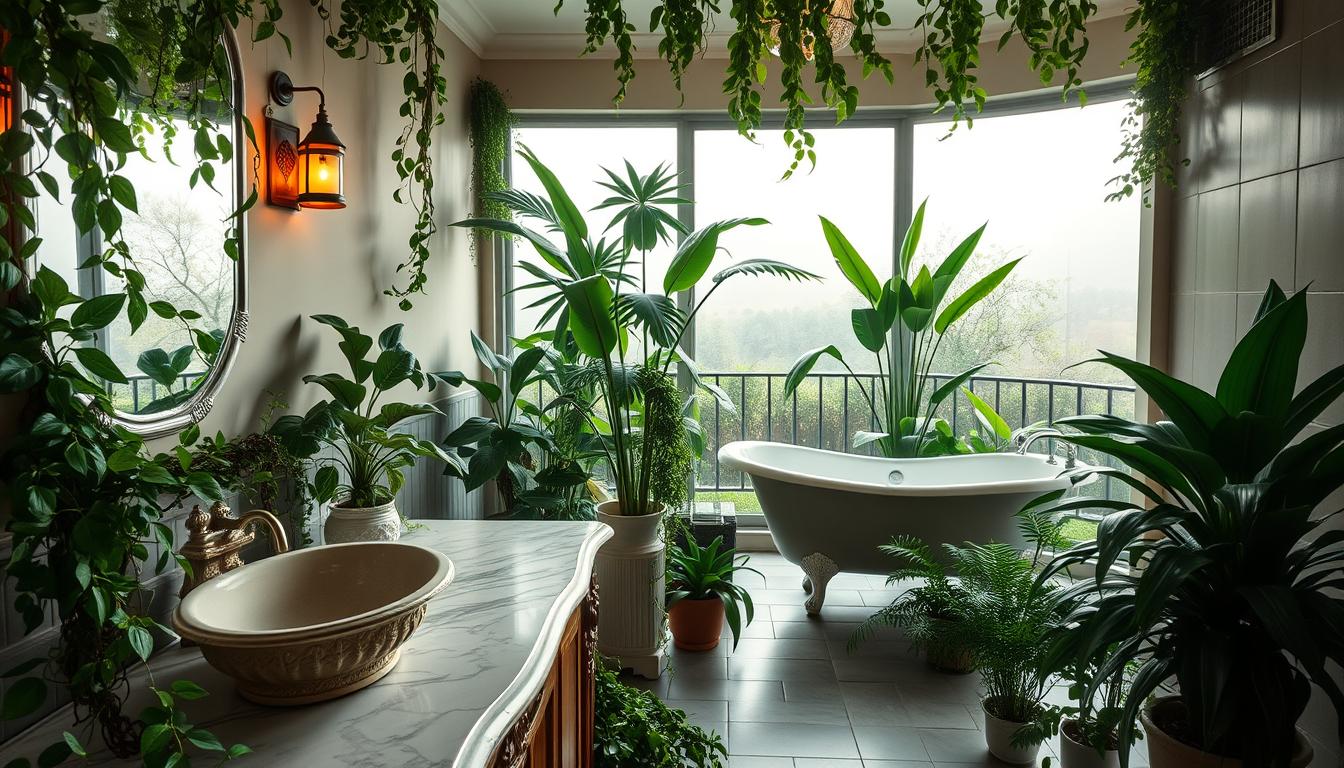Keeping your bathroom clean is key, especially for fake plants. These plants brighten your room but catch a lot of dust. This guide will show you how to properly clean your faux plants. By doing this, they will stay beautiful and less dusty. With the correct cleaning methods, your artificial plants will always look great.
Understanding the Importance of Cleaning Fake Plants in the Bathroom
Cleaning fake plants in your bathroom is important for looks and health. Regular cleaning makes your plants appear fresh and clean. It also stops dust from gathering. Too much dust can hurt your home’s air quality.
Reasons to Keep Your Faux Plants Dust-Free
Keeping faux plants free of dust makes your home nicer to live in. Some reasons are:
- Improved appearance of your bathroom decor.
- Enhanced faux plants hygiene, preventing dust buildup.
- Reduction in allergens that can trigger respiratory issues.
Health Impacts of Dust Accumulation
Dust can harm your health more than you might think. Its accumulation leads to problems like:
- Exacerbation of asthma and allergy symptoms.
- Potential breathing difficulties for sensitive individuals.
- Deterioration of overall air quality in enclosed spaces.
How Dust Accumulates in Bathrooms
Bathrooms are key places for dust to gather because of bathroom humidity. The air’s extra moisture makes dust stick to surfaces better. This happens because steam from showers and baths mixes with the air.
Humidity and Its Role in Dust Cohesion
Bathroom humidity impacts how dust acts. When there’s more humidity, dust gets moist, becomes heavier, and falls onto surfaces easier. This moisture makes the dust stick like glue to counters and decor.
Keeping towels fresh and using exhaust fans can lower humidity.
Sources of Dust and Allergens
Many things add to the dust in bathrooms. Some common sources are:
- Hair and skin cells that people shed
- Fiber from towels and bathmats
- Leftovers from cleaners and soaps
- Pollen and dust from outside
It’s important to tackle these dust sources. Doing so keeps surfaces clean and the air healthier.
Bathroom Fake Plant Dust Traps (And Exactly How to Clean Each Type)
Fake plants can make your bathroom look peaceful. Yet, they still need some care. Knowing about the different materials used in fake plants helps choose how to clean them. Each material needs its own way of care to keep the plants looking good and lasting long.
Common Materials Used in Faux Plants
Fake plants are made from different things, like:
- Polyester
- Polystyrene
- Rubberized plastics
Each material used in fake plants needs a certain way to clean. For example, you can gently wash polyester plants. But, polystyrene plants need more care to avoid harm. Knowing about these materials helps in taking good care of your plants. This makes sure your fake greenery stays bright.
Specific Care for Different Types of Artificial Foliage
To keep fake foliage looking nice, it’s important to clean it the right way:
- For solid plastic plants, rinse with warm water or wipe with a damp cloth.
- Porous materials like some rubberized leaves can catch dirt. They need to be cleaned carefully to stop water from soaking in.
- Always look at the manufacturer’s advice, which tells you how to take care of each type of fake plant.
Looking after your plants is more than just dusting them off. Knowing about the materials they’re made from and how to care for them keeps them beautiful. And it doesn’t hurt your bathroom’s fake plants.
Essential Tools for Cleaning Artificial Plants
Keeping artificial plants beautiful needs the right tools. If you have the correct cleaning tools, it makes the job smooth and efficient. Dusting tools are key to remove dust and keep fake plants looking bright. Choosing the right tools makes cleaning simpler and keeps your plants in good shape longer.
Best Cleaning Cloths and Dusters
Microfiber cloths are top picks for cleaning. They catch dust well and don’t scratch. Soft dusters are great for fragile plants. They remove dust gently. These tools ensure your decorations stay clean and look great without damaging them.
Specialized Tools for Hard-to-Reach Areas
For plants in tough spots, specific tools are crucial. Long-handled dusters clean high or ceiling-hung plants with ease. Paintbrushes are perfect for detailed spots to minimize dust buildup. Using these tools makes your cleaning more effective, keeping your artificial plants looking nice.
Effective Cleaning Techniques for Bathroom Fake Plants
Keeping fake plants clean is key to making them look real and fresh. It’s important to dust them regularly. This way, they stay looking good without getting dirty. Cleaning fake plants the right way also makes your bathroom look better.
Dusting Method with Microfiber Cloths
Microfiber cloths are great for cleaning fake plants. They pick up dust well without harming the plants. Here’s the best way to use them:
- Start at the top and gently wipe the leaves and stems down.
- Use a dry cloth to keep away mold caused by dampness.
- If dust is hard to remove, try a barely moist cloth but not too wet.
Using Paintbrushes and Compressed Air
Paintbrushes help clean spots that are hard to reach. They’re gentle on the plants too.
- Pick a soft, clean paintbrush for the delicate parts of the plants.
- Brush lightly on leaves and petals to get the dust off.
- Compressed air is another good option. It blows dust away from tight spots. Just be careful not to get the plants wet.
These methods not only make faux plants look better but also last longer. When you dust them on a regular basis, your fake bathroom plants will always seem bright and new.
Washing and Rinsing Methods for Faux Plants
To keep faux plants looking new, proper care is key. Knowing what your faux plant is made of helps a lot. Each type needs a different way to be cleaned to stay nice and undamaged.
Best Practices for Solid Plastic Plants
Cleaning solid plastic faux plants is pretty easy. Here are the best steps for cleaning them:
- Rinsing the plant under cold water to remove dirt and debris.
- Using a soft brush to gently scrub any stubborn spots.
- Wiping the leaves with a damp cloth for a final polish.
Risks of Washing Porous Products
Be careful when washing porous faux plants. They can soak up water and hold onto dirt. Here’s what to consider:
- Avoid soaking or rinsing directly, as this may lead to permanent staining.
- Opt for spot cleaning with a damp cloth or sponge.
- Review manufacturer instructions to determine the safest cleaning method.

Natural Cleaning Solutions for Artificial Plants
Keeping your fake plants beautiful means choosing the right cleaning ways. Using natural cleaning solutions is good for the environment and safe for your faux plants. These methods keep your artificial greens looking bright and dust-free.
Benefits of Using White Vinegar
White vinegar is great for cleaning because it’s a natural solvent. Mixed with water, it removes dust from fake plants and gets rid of smells. Its acidity cuts through dirt without harming the plant’s surface. This makes it a safer option than many regular cleaners.
Other Eco-Friendly Cleaning Options
There are other green ways to take care of your plants besides white vinegar:
- Baking soda: It scrubs away hard stains and gets rid of bad smells.
- Diluted disinfectants: They can kill germs and mildew without strong chemicals.
Using these natural cleaners helps the planet and keeps your fake plants looking great. It prevents them from being harmed by harsh chemicals.
Avoiding Common Mistakes in Cleaning Faux Plants
It’s key to keep faux plants looking fresh and bright. But, cleaning them wrongly can do harm. Knowing the don’ts in cleaning faux greenery saves time and money.
What Not to Use: Harsh Chemicals and Cleaners
Harsh chemicals can cause big problems. Bleach and strong solvents wear down materials. They can turn faux plants’ colors and textures bad. It’s better to use gentle, made-for-artificial-plants cleaners instead.
Checking Manufacturer Labels Before Cleaning
Always look at what the maker says before you start cleaning. Labels often have tips on how to clean right. Doing this helps avoid mistakes and keeps your faux plants looking good.
Long-Term Maintenance Tips for Clean Faux Plants
To keep faux plants looking new, a little upfront effort is needed. Applying a special sealant can reduce dust, keeping them clean. Keeping up with care routines is key for their look and cleanliness.
Sealing to Prevent Future Dust Build-Up
Use sealants made for faux plants to cut down on dust. This layer makes the plants last longer and easier to clean. Make sure the sealant works well with your plants to keep them good as new.
Regular Care Routines to Follow
It’s vital to have a care routine for your faux plants. Think about these tips:
- Dust weekly using a microfiber cloth to keep surfaces clean.
- Conduct periodic deep cleanings every few months, employing gentle washing techniques.
- Rotate the placement of plants to minimize fading from direct sunlight exposure.
These care tips help keep faux plants looking great. They’ll look beautiful and add to your space’s vibe.
Conclusion
Keeping fake plants clean in your bathroom is key for looks and health. Clean plants mean less dust and allergens. Using the right methods and products makes your space better.
Good fake plant care makes your bathroom look great and helps keep it healthy. Following these tips means enjoying indoor greenery without dust trouble.
Looking after your faux plants is about more than cleaning. It’s about making your home feel welcoming. Use these tips, and your fake plants will add to a lovely home vibe.



